1930s
Does college turn young women into communists?
Back in the 1930s families were concerned about whether they should send their young daughters off to college, fearing they might come home infected with communism. So in 1934, psychologist Stephen M. Corey set out to determine whether such fears were justified.Corey administered the Thurstone Attitude Scale to 234 female freshmen at the University of Wisconsin, examining their attitudes with respect to six topics: Reality of God, War, Patriotism, Communism, Evolution, and Church. A year later he retested 100 of these students when they were sophomores.

Godless communists?
When he presented his findings at the Midwestern Psychological Association convention in May 1940, he assured everyone that it was safe to send young women to college, saying, "There was no great difference in the girls' attitudes. The average co-ed apparently would rather mix with stag lines than picket lines."
He also emphasized that the young women lost none of their feminine habits at college. A United Press reporter paraphrased his words:
However, if you look at his 1940 article in the Journal of Social Psychology*, in which he published the results of his study, you find somewhat different information. There he revealed that after a year at college the attitudes of the young women did change slightly, but consistently, in the direction of liberalism — which is to say that they showed less sympathy for god, war, patriotism, and the church, and more sympathy for communism and evolution.

Corey wrote in that article, "The opinions of the students appeared to have undergone at least a degree of liberalization during their one year of attendance at a University."
I guess he wasn't actually lying to the folks at the Midwestern Psychological Association. It's all how you choose to spin the data.
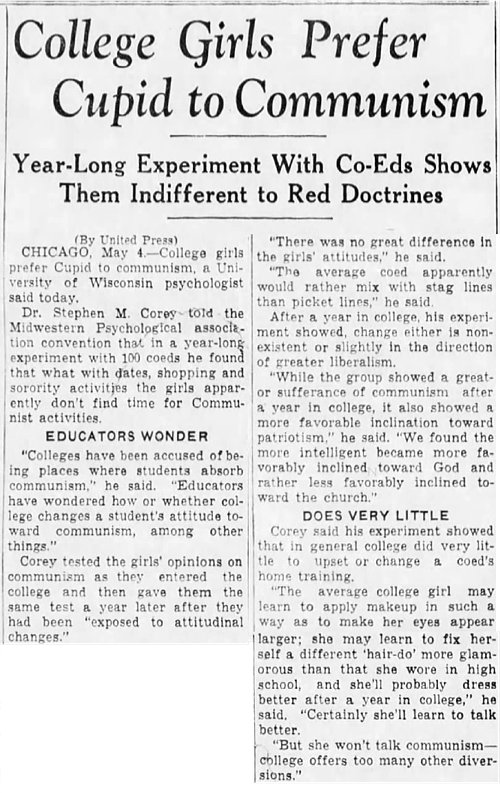
San Bernardino County Sun - May 5, 1940
* Corey, S.M. (1940). "Changes in the opinions of female students after one year at university." The Journal of Social Psychology, 11: 341-351.
Posted By: Alex - Wed Aug 17, 2022 -
Comments (4)
Category: Psychology, 1930s, Women, Universities, Colleges, Private Schools and Academia
Melvin Purvis’s G-Men Detective Game
Play along with current headlines!
The object of the game is to capture the Public Enemy. The player who brings a G-Man together with the Public Enemy wins the game. The game starts with one G-Man chasing the public enemy, but after 30 minutes a second can be brought into play.
More pix and info here.
Melvin Purvis at Wikipedia.
Posted By: Paul - Sat Aug 13, 2022 -
Comments (0)
Category: Crime, Games, 1930s
United States v. 350 Cartons of Canned Sardines
This case is known in legal circles primarily because of its odd name.It occurred in 1934 and involved 350 cartons of canned sardines shipped from California to Pennsylvania. The FDA examined some of the cans at its lab in Washington DC and decided that they contained "decomposed animal substance." Therefore, it ordered all 350 cartons to be destroyed.
The sardine company challenged this order in court. It lost the initial case, but won on appeal. Though, by that time, two years later, the sardines may already have been destroyed.
As far as I can tell, the case represented a power struggle between the California inspectors (who had approved the fish for shipment) and the federal ones. The FDA's decision seems to have been somewhat arbitrary. Its inspector decided the fish were decomposed not because of how they smelled or tasted. He said they smelled fine. He concluded they were 'decomposed' simply because they looked slightly pink — which was probably because they had been cooked in tomato sauce.
Read more about the case here.
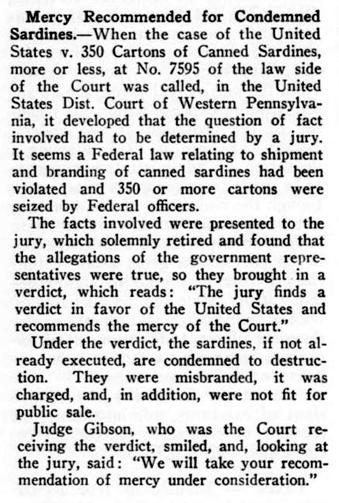
Case and Comment - Autumn 1934
Posted By: Alex - Wed Jul 13, 2022 -
Comments (2)
Category: Odd Names, Lawsuits, 1930s
Follies of the Madmen #537
Police brutality!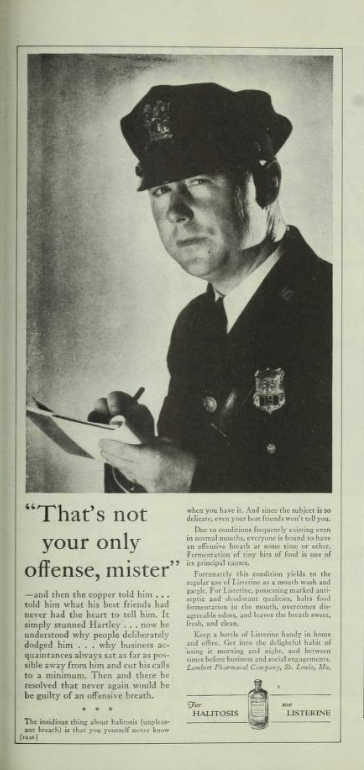
Source.
Posted By: Paul - Mon Jul 11, 2022 -
Comments (2)
Category: Hygiene, Police and Other Law Enforcement, Advertising, 1930s
Rebla, the Comedy Juggler
A small encyclopedia entry on the man.
Posted By: Paul - Tue Jul 05, 2022 -
Comments (0)
Category: Human Marvels, Theater and Stage, Vaudeville, 1930s
Word-Counter for Typewriters
Any user today of word-processing software knows instantly how many words a document contains. Could similar information be obtained for a typewritten document? Certainly!The US Patent Office features several documents for similar devices, but I'm not sure they were ever produced. They had the theoretical advantage of also being hooked to various punctuation keys, so that when you hit such a key, the counter would also recognize the end of a word, as well as with the space bar.
Source.
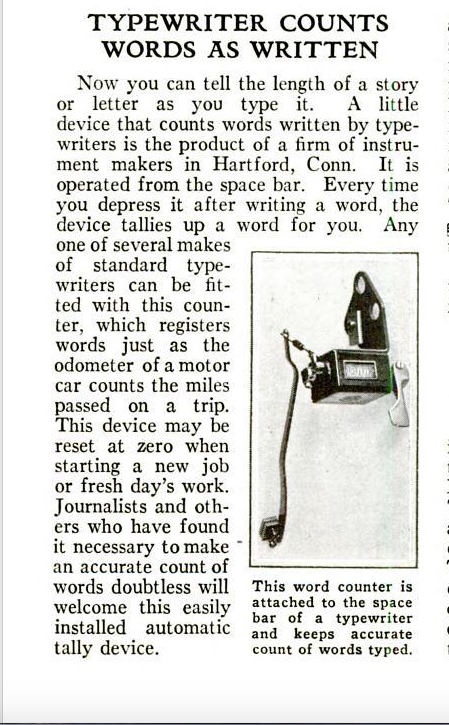
Posted By: Paul - Mon Jul 04, 2022 -
Comments (0)
Category: Inventions, Offices, Business Supplies, Institutional Regulations, 1930s
Bernard Bernard’s Height Increaser For Short People
"The patient lifted himself by the chin which was cradled in a sling attached to ropes looped to an overhead beam."In 1937, the American Medical Association warned the public that this device, despite being widely advertised, didn't actually work.

The Muncie Star Press - Apr 9, 1937
Update: The inventor of this device was a man named Bernard Bernard who was, himself, only 5 feet 1 inch tall. Details from Hygeia (May 1936):
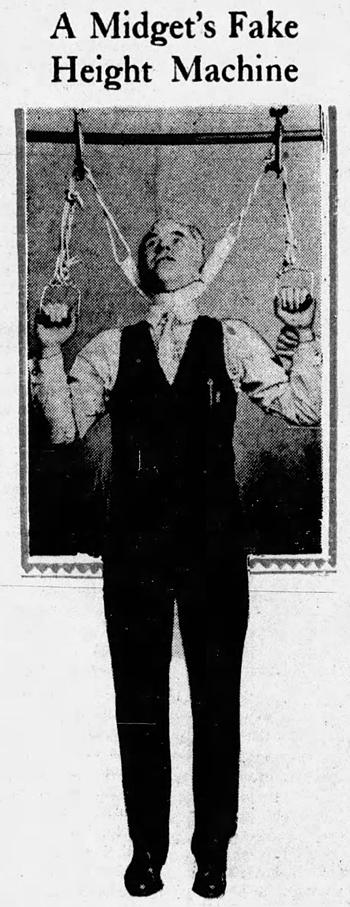
LA Times - July 31, 1932

LA Times - May 1, 1930
Posted By: Alex - Sat Jul 02, 2022 -
Comments (8)
Category: Inventions, Patent Medicines, Nostrums and Snake Oil, 1930s
Love lost due to “middle-age” skin
What foolishness to grow older!
1938 - NY Times. Via Duke University
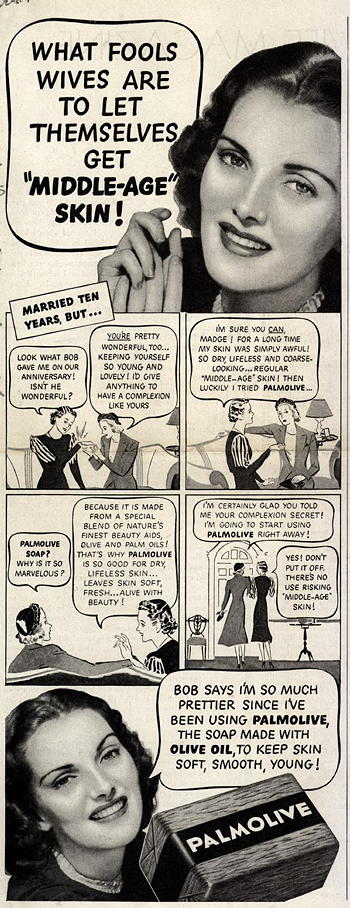
Posted By: Alex - Wed Jun 29, 2022 -
Comments (1)
Category: Advertising, 1930s, Skin and Skin Conditions
Payment in Clams
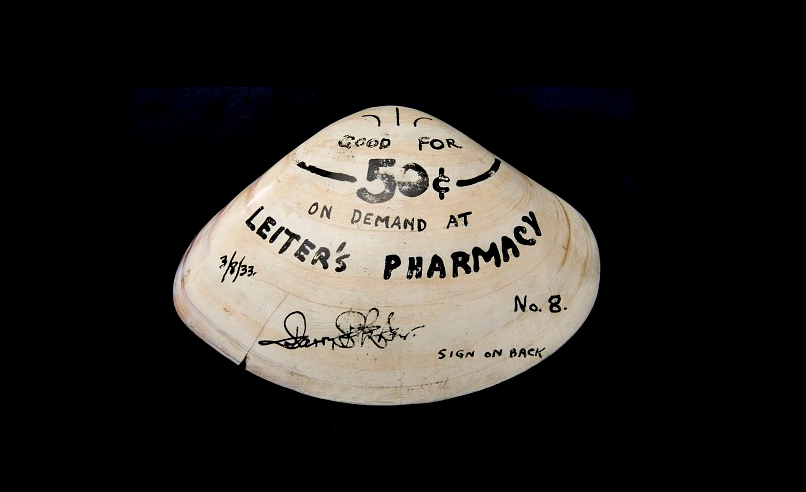
When the nation's banks closed during the Depression, Leiter's Pharmacy in Pismo Beach, California, issued this clamshell as change.
The 1929 stock market crash triggered banking panics, as people rushed to withdraw their savings before they were lost. In March 1933, President Roosevelt ordered a four-day bank holiday to prevent further withdrawals. To compensate for the currency shortage, communities created emergency money, or scrip. This clamshell was signed as it changed hands and redeemed when cash became available again.
Source.
Posted By: Paul - Mon May 16, 2022 -
Comments (2)
Category: Money, Nature, 1930s
Metallic Swim Suit
Apr 1938: Ruth Williamson demonstrated that "nothing short of a saw or file" would damage the metallic bathing suit she was modeling.Because withstanding saw and file is an important quality for a bathing suit.
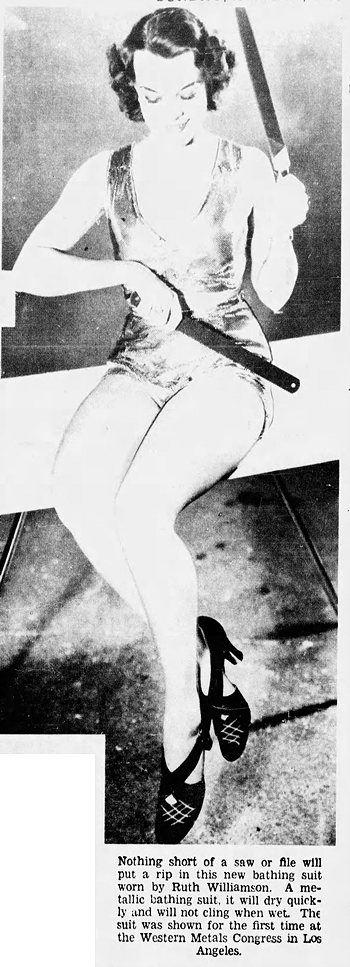
Pittsburgh Press - Apr 17, 1938

NY Daily News - Mar 27, 1938
Posted By: Alex - Fri May 13, 2022 -
Comments (5)
Category: Fashion, 1930s

| Who We Are |
|---|
| Alex Boese Alex is the creator and curator of the Museum of Hoaxes. He's also the author of various weird, non-fiction, science-themed books such as Elephants on Acid and Psychedelic Apes. Paul Di Filippo Paul has been paid to put weird ideas into fictional form for over thirty years, in his career as a noted science fiction writer. He has recently begun blogging on many curious topics with three fellow writers at The Inferior 4+1. Contact Us |




